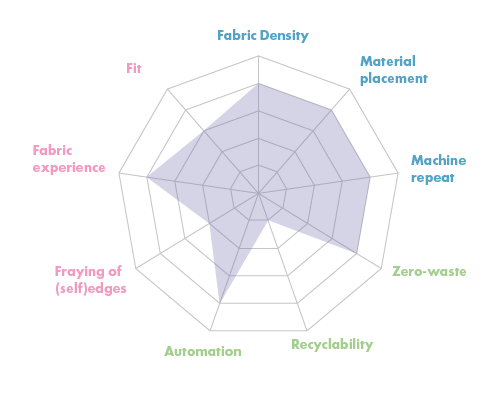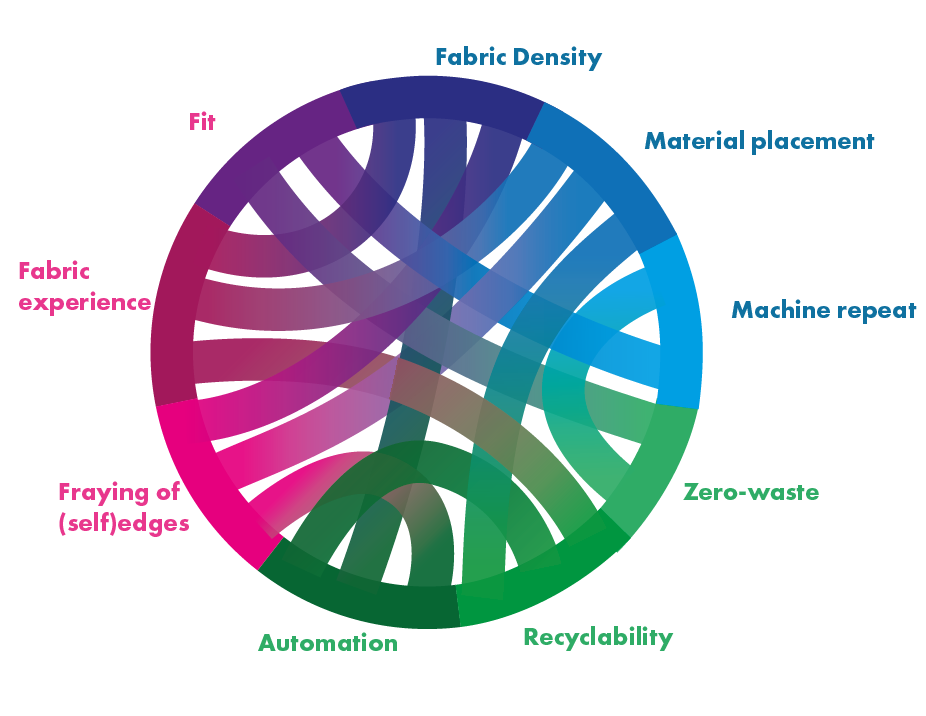Reflective Mapping
Reflective mapping is designed to help to comprehend the implications of your work beyond the loom and to help you determine what goals you find important in your project. The radar charts help you to reflect on your process and samples, but also visualise the challenges you are navigating in your practice to collaborators.

Fig. 1 A spider chart example
The radar charts, used in Chapter 5 of the thesis to reflect on the trouser iterations, are filled in with categories that were important to this research project, but they can be adjusted according to your goals in a project. These charts are useful because they display the different tangible and hidden variables you work with and provide a visualization of the process.

Fig. 2 Shows how the different variables influence each other
Fabric density: In the context of woven textile-forms and industrial looms, the density of warp and weft threads is critical to consider, as it impacts the possibilities for designers. Therefore, the density is assessed based on the balance between single and multilayer sections. The more layers a fabric has, the more design possibilities, but also the more challenging it is to design a good balance between single and multi-layer sections.
Material placement: Material placement in jacquard weaving refers to the positioning of the warp and weft threads in the fabric. Every weft thread is distributed throughout the whole width of the loom, and therefore it is not possible to change the composition and location of threads without creating waste. Therefore, in woven textile-form production, material placement is critical to consider. Ideally, each yarn has a function in each section of the garment.
Machine repeat: A repeat on a jacquard loom refers to the number of times a pattern is repeated across the width of the fabric being woven. This can affect the size of a garment that can be woven, and the possibilities in the zero-waste garment design. No repeat on the jacquard loom allows for more flexibility in the design placement, and an uneven repeat size will make it very difficult to design a zero-waste garment, as it is not possible to perfectly repeat the garment multiple times.
Zero-waste: This section examines the amount of waste generated during the design process. Holly McQuillan’s garment design is essentially zero-waste; however, depending on the loom repeat and machine setup, it may or may not be possible to weave the garment without creating waste on the loom.
Recyclability : The use of multiple types of fibers makes it more difficult to recycle a garment. Therefore, the goal is to develop mono-material garments. However, it is often not possible to change the warp for prototyping woven textile forms due to the time-consuming and expensive nature of the process. Therefore, changing a material in the weft may also affect the recyclability of the garment.
Automation: One of the benefits of developing WTfs is to reduce the number of production steps required to make a garment. However, depending on the design, finishing, materials, shrinkage, and other factors, the degree of automation in the production of WTf can change.
Fraying : Because WTf consists of multiple layers, there are almost always layers that need to be cut. Most woven fabrics will fray once they are cut, but the amount of fraying can be limited through the textile structure and angle of cutting in relation to the warp and weft. In this garment, the goal is to use as few production steps as possible. Therefore, the aim is to leave as many edges as possible without requiring an extra post-production step.
Fabric experience: The way we experience a fabric depends on its density, the materials used, and its weave structure. Naturally, we want garments to feel comfortable on our skin and allow for ease of movement without excessive wrinkling. However, due to the setup of a jacquard loom, it is not always possible to create a prototype using a single material, and material blends can affect recyclability.
Fit: The fit of a garment to our bodies is naturally important. It’s interlinked with other aspects of garment production because of the aim of zero-waste production. This, in turn, is connected to the size of the loom and the number of repeats required.